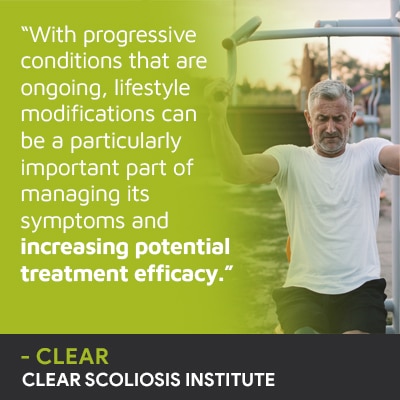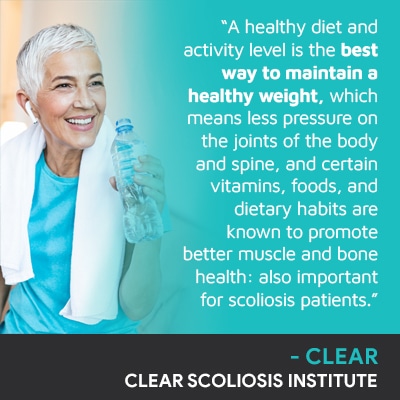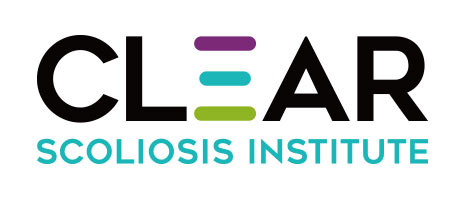
For people with scoliosis, leading a spine-friendly lifestyle is important, and this includes a healthy activity level and diet. Staying active and eating healthy foods alone can't correct scoliosis, but it can help create an internal environment that's more conducive to healing.
Scoliosis causes the spine to bend and rotate unnaturally, and while diet alone can't correct scoliosis, it can help in a number of ways. From maintaining a healthy weight to increasing energy, a diet that's rich in vitamins, protein, and calcium can make the body more responsive to treatment.
Before getting to 4 specific dietary changes that should be factored into a scoliosis-friendly diet, let's talk generally about how scoliosis affects the body.
Living with scoliosis means an unnatural sideways-bending spinal curvature has developed, and as the spine also rotates, scoliosis is a 3-dimensional progressive condition.

As the nature of scoliosis is to become more severe over time, proactive treatment is important, and a healthy lifestyle can make the body more responsive to treatment.
Conservative treatment doesn't just focus on the spine but also on the condition's effects, which can include the entire body.
Leading a spine- and scoliosis-friendly lifestyle can help increase treatment efficacy and sustain long-term results.
Scoliosis can range in severity from mild scoliosis to moderate and severe cases, and the more severe, the more noticeable its effects are going to be.
Living with scoliosis means managing its symptoms and progression, and progression is triggered by growth.
Managing the symptoms of scoliosis effectively is also key to quality of life; if left untreated, the nature of scoliosis is to become more severe.
Severe scoliosis can cause complications such as breathing problems, digestive issues, and is more likely to require invasive spinal fusion surgery.
The main symptoms of scoliosis in children involve postural changes such as uneven shoulders and hips, and movement changes are also common, and as scoliosis is an asymmetrical condition, it can cause unhealthy movement patterns to develop.
In adults, the main symptom of scoliosis is pain caused by compression, and the best way to minimize the effects of scoliosis is to treat it proactively, and any lifestyle changes that make the body and spine more responsive to treatment can be helpful, including diet.
Scoliosis treatment is shaped by a number of factors including patient age, condition type, severity, and curve location, and how responsive the body is to treatment will also depend on a number of factors.
A healthy body is more likely to respond well, and faster, to treatment, and considering a focus of nonsurgical treatment is scoliosis-specific exercise, a patient who is physically fit is going to be more capable of performing key therapeutic exercises as part of treatment.
A healthy diet gives people more energy for a better quality of life and makes patients better able to handle the challenges of scoliosis and scoliosis treatment.

While improvements to diet alone can't treat scoliosis, when combined with the potential of a proactive treatment plan, it can help make the body healthier, stronger, and more responsive to treatment, so let's explore 4 dietary changes recommended for scoliosis patients.
A higher intake of fruits and vegetables is associated with lower weight and increased energy levels, and patients with more energy not only tend to have better mental health, but are also more physically capable of handling intense treatment plans and achieve motivating results faster.
Fruits and vegetables are also loaded with essential vitamins and minerals that can reduce the risk of certain diseases and are essential for a number of bodily functions and a healthy immune system.
Fruits and vegetables are also good sources of fiber, and a high-fiber diet is associated with a healthy digestive system, weight management, and can help regular blood sugar and prevent diabetes.
When possible, scoliosis patients should consider increasing their intake of fresh broccoli, carrots, dark leafy greens, spinach, avocado, tomatoes, apples, bananas, and berries for more energy, better digestion, immunity, and overall health.
A diet that's high in protein can make it easier to increase muscle strength, and a focus of scoliosis treatment is on increasing the strength of the spine's surrounding muscles so the spine is optimally supported and stabilized.
As protein helps build muscle, a high-protein diet can make the body stronger and more responsive to physical therapy and a number of scoliosis-specific exercises.
Increasing consumption of lean non-processed meats and protein sources like chicken, turkey, and fish can help make the body more responsive to strength-building exercise to increase the spine's support and stability.
Foods that are high in calcium promote bone health, and vitamin D deficiency has been linked with the development of adolescent idiopathic scoliosis.
Adolescent idiopathic scoliosis has also been linked with low bone density, and as vitamin D increases calcium absorption, increasing foods high in calcium and vitamin D such as milk, eggs, yogurt, and cheese can help maintain strong and healthy bones.
Adequate calcium and vitamin D intake is also needed to prevent bone loss: a leading cause of injury, particularly when it comes to falls in older adults with degenerative scoliosis.
While water isn't a food, increasing daily hydration is one of the simplest and most effective positive dietary changes a person can make.
Not only does a hydrated body function better in general, it helps with muscle health, and hydration is also particularly important for the discs of the spine.
The discs give the spine structure, facilitate its flexibility, provide cushioning between vertebral bodies, and act as the spine's shock absorbers.
Most spinal degeneration starts in the intervertebral discs that lose fluid as we age, and as the discs don't have their own vascular supply, increasing circulation and staying hydrated is a simple way to work towards preserving disc health and function, which is essential for overall spinal health.
Discs that become desiccated can become bulging and/or herniated discs and cause instability, pain, and mobility issues.
So one of the first dietary changes I recommended to scoliosis patients is increasing daily hydration to improve muscle, disc, and overall health.
While diet and exercise alone can't address the structural nature of scoliosis, they can help make the body stronger and more responsive to treatment.
A diet that's high in fruits and vegetables can improve digestion, heart and blood health, can increase energy levels and help manage weight: particularly important for people with scoliosis whose spines are already strained.
Increasing protein intake is recommended for anyone trying to increase muscle strength, and for people with scoliosis, a key focus of conservative treatment and correcting scoliosis is improving the spine's surrounding muscle strength for better stability.
A diet that's high in calcium and vitamin D can help promote bone health and prevent bone loss, and this can be particularly helpful for older adults dealing with degenerative scoliosis; improving bone health can help prevent harmful fractures in the event of a fall.
Staying hydrated is key to overall health, and in the context of scoliosis, it's particularly relevant in terms of muscle and spinal health. Muscles that are hydrated are more resistant to tension and strain, and staying hydrated is key to spinal health as dehydrated discs can lead to a number of spinal conditions/issues.
Here at the CLEAR Scoliosis Institute, our care is patient-centered and conservative, and lifestyle guidance can be an important facet of rehabilitative treatment.

CLEAR provides a unique and innovative way of understanding scoliosis. Sign up to receive facts and information you won’t find anywhere else.
